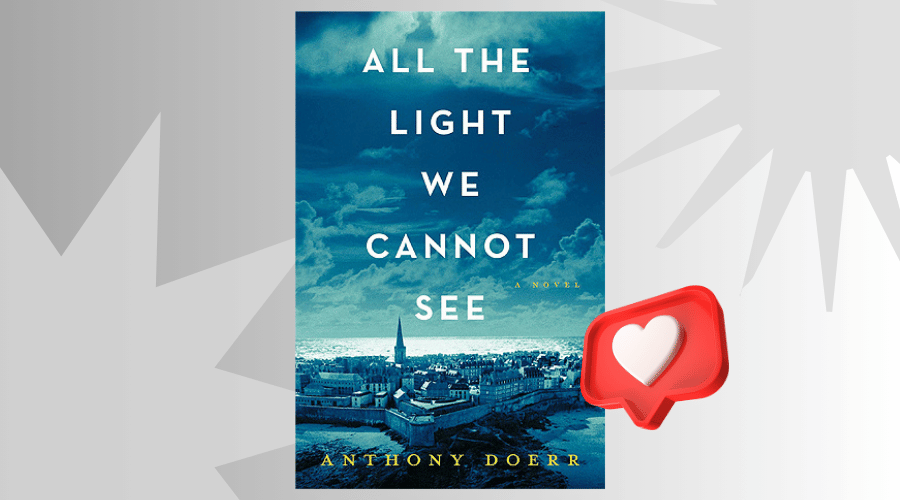All the Light We Cannot See by Anthony Doerr is a historical novel set during World War II, following the lives of two young characters on opposite sides of the conflict. Marie-Laure is a blind French girl whose father, a locksmith at a museum, hides a valuable gemstone to protect it from Nazi looters. Werner is a German orphan with a talent for fixing radios, which eventually lands him in the German military. As their stories unfold, their paths cross in a small town in France, leading to a powerful connection amidst the devastation of war. Through breathtaking prose and vivid imagery, Doerr explores themes of resilience, fate, and the quiet beauty that survives even in the darkest of times.

| Author | Anthony Doerr |
| Publication date | May 6, 2014 |
| Goodreads Rating | 4.31 |
| Pages | 544 |
| ISBN | 1476746583 |
| Topics | Historical Fiction, Fiction, Historical, War, World War II, Adult, France, Literary Fiction |
All the Light We Cannot See Book Summary
All the Light We Cannot See by Anthony Doerr is a deeply moving, intricately woven story set against the backdrop of World War II, following the lives of two young individuals from opposite sides of the conflict. Marie-Laure LeBlanc is a blind French girl whose life is filled with wonder, curiosity, and resilience. Raised by her father, who works as a locksmith at the Museum of Natural History in Paris, Marie-Laure learns to navigate the world through touch and sound. Her father creates intricate miniature models of their neighborhood to help her find her way, fostering a deep bond between them. When the Nazis occupy Paris, Marie-Laure and her father flee to the coastal town of Saint-Malo, where her great-uncle Etienne lives, and they take with them a mysterious gemstone known as the Sea of Flames, believed to bring immortality at a devastating cost.
Across the border in Germany, Werner Pfennig is a young orphan with a keen mind for mechanics and engineering, particularly in building and repairing radios. Growing up in an orphanage with his sister Jutta, Werner’s early dreams of a life beyond coal mining are shaped by his fascination with science and technology. His talents eventually capture the attention of the Nazi regime, and he’s recruited into a brutal academy for Hitler Youth. Despite his inner conflict, Werner is thrust into the war effort, tasked with using his radio expertise to locate resistance fighters broadcasting against the Nazi regime.
As the war escalates, Marie-Laure and Werner’s lives become entangled. Marie-Laure joins her great-uncle in secretly broadcasting messages to inspire hope and resistance among the people of occupied France. Meanwhile, Werner, haunted by the moral implications of his role, finds himself tracking these very broadcasts. When the battle reaches Saint-Malo, their paths converge in a climactic encounter that reveals the profound ways in which individuals can touch each other’s lives, even across divides of ideology and conflict.
Doerr’s prose brings Saint-Malo’s cobblestone streets, the tension of German bunkers, and the wonder of Marie-Laure’s tactile world to vivid life. Through alternating perspectives and timelines, he explores the impact of war on the human spirit, the costs of survival, and the courage it takes to choose compassion over cruelty. The title itself, All the Light We Cannot See, captures the essence of the unseen bonds that connect people, the hidden beauties and tragedies of human existence, and the way hope shines through even the darkest moments. This novel reminds readers of the power of resilience, kindness, and the small acts of bravery that can leave a lasting impact.
A winner of the Pulitzer Prize for Fiction, All the Light We Cannot See is a haunting and unforgettable portrayal of the individuals who endured and resisted the horrors of WWII, illuminating the intricate beauty of the human spirit that persists even when surrounded by devastation.

All the Light We Cannot See: Characters
Here’s a rundown of the key characters in All the Light We Cannot See:
- Marie-Laure LeBlanc – A blind French girl with an immense curiosity for the world. Marie-Laure grows up in Paris with her father, who works as a locksmith at the Museum of Natural History. She has a resilient spirit, and her love for books and exploration helps her navigate the challenges of being blind in a war-torn world. When the Nazis invade, she and her father flee to Saint-Malo, where she ultimately becomes involved in the French Resistance.
- Werner Pfennig – A German orphan with a talent for engineering, especially radios. Werner is raised in a poor mining town with his sister, Jutta, and dreams of escaping his grim future in the mines. His radio skills draw the attention of Nazi recruiters, and he is eventually drafted into the military. Though initially obedient, Werner struggles with his moral beliefs as he witnesses the atrocities of the Nazi regime.
- Daniel LeBlanc – Marie-Laure’s devoted father, who works as a locksmith at the museum in Paris. He is fiercely protective of Marie-Laure and creates miniature models of their neighborhood to help her learn her surroundings. When war breaks out, he is entrusted with a mysterious gemstone, the Sea of Flames, which he takes with him to Saint-Malo to keep it out of Nazi hands.
- Etienne LeBlanc – Marie-Laure’s great-uncle, a reclusive World War I veteran suffering from trauma and reclusive tendencies. He lives in Saint-Malo and becomes a surrogate family member to Marie-Laure after she and her father flee Paris. Despite his fears, Etienne plays a vital role in the French Resistance by broadcasting messages through a hidden radio.
- Reinhold von Rumpel – A Nazi officer and gemologist who is obsessed with finding the Sea of Flames, the valuable gemstone Marie-Laure’s father hid. Von Rumpel is persistent and ruthless, believing that the gemstone will grant him the immortality he desires as he battles terminal illness. He becomes one of the central antagonists, relentlessly pursuing Marie-Laure and her family.
- Jutta Pfennig – Werner’s younger sister and his moral compass. Jutta has a keen sense of right and wrong and frequently questions the propaganda of the Nazi regime. Her letters to Werner remind him of the world outside his training and, ultimately, the humanity he struggles to hold onto.
Each of these characters adds depth to the novel’s exploration of war, resilience, and the choices people make in difficult times. Their lives intersect in unexpected and powerful ways, bringing light to the story’s exploration of human connection amidst conflict.
All the Light We Cannot See: Werner Death
Werner’s death in All the Light We Cannot See is tragic and symbolic, underscoring the senseless loss of life caused by war. After helping Marie-Laure escape from Saint-Malo, Werner is captured by Allied forces and held in a makeshift prison. In a moment of disorientation while trying to escape a minefield, Werner steps on a hidden landmine, which explodes, killing him.
His death is heartbreaking, especially because, by this point, Werner has started to question the Nazi ideology he was indoctrinated into and has found a glimmer of purpose and connection with Marie-Laure. Werner’s death highlights the cruelty of war, which takes young, promising lives just as they begin to find their own path. It’s a poignant moment that stays with readers, emphasizing the novel’s message about the tragic waste and lost potential that war often brings.
All the Light We Cannot See: Review
All the Light We Cannot See by Anthony Doerr is a stunning, poignant novel set during World War II, following two young lives on opposite sides of the conflict. Marie-Laure, a blind French girl, and Werner, a German orphan with a gift for radios, each navigate the horrors of war, and their paths ultimately cross in the besieged town of Saint-Malo. Doerr’s lyrical writing and detailed storytelling bring their worlds to life, exploring themes of resilience, fate, and the bonds that unite us even in darkness.
The novel’s structure, with alternating timelines and perspectives, builds suspense and emotional depth, though some may find the pacing a bit slow. However, Doerr’s poetic prose and intricate characters make up for it, resulting in a story that is both heartbreaking and inspiring. This Pulitzer Prize-winning book is an unforgettable exploration of humanity’s quiet strength, capturing how beauty and light persist even amid destruction.
📚 Explore more: All the Light We Cannot See: Book Club Questions and Discussion Topics
All the Light We Cannot See: Age Rating
All the Light We Cannot See is generally recommended for readers aged 14 and up. The book deals with mature themes, including the horrors of war, moral dilemmas, violence, and loss, which may be more suitable for older teens and adults who can grasp its emotional and historical depth. There isn’t explicit content, but the intense themes and nuanced storytelling make it ideal for high school students and above who are comfortable with complex narratives.
All the Light We Cannot See: Is it a True Story?
All the Light We Cannot See is a work of fiction, though it is heavily inspired by real historical events and settings from World War II. While the characters of Marie-Laure and Werner are fictional, Anthony Doerr based much of the story on the real destruction of the French town of Saint-Malo, which was bombed extensively by Allied forces in 1944. The novel also reflects historical elements, like the Nazi youth programs that influenced young Germans like Werner, and the French Resistance’s clandestine use of radio broadcasts.
All the Light We Cannot See: Genre
All the Light We Cannot See is primarily classified as historical fiction. It combines elements of war fiction with a focus on human resilience and connection during World War II. The novel also touches on coming-of-age themes, as it follows the young protagonists, Marie-Laure and Werner, through their formative years amidst the chaos of war. Its lyrical, almost poetic style gives it a literary fiction quality, and it has also been appreciated for its suspenseful elements, making it a multifaceted story that appeals to readers across genres.
All the Light We Cannot See: Ending
The ending of All the Light We Cannot See is both bittersweet and reflective, bringing closure to the journeys of Marie-Laure and Werner, while also highlighting the enduring effects of their experiences.
In the final chapters, Marie-Laure and Werner’s paths intersect briefly in the war-torn city of Saint-Malo. Werner, a young German soldier tasked with finding illegal broadcasts, discovers Marie-Laure hiding in her great-uncle Etienne’s house, where she has been courageously transmitting resistance messages. Rather than turning her in, Werner chooses compassion and helps Marie-Laure escape the violence engulfing the city. They share a brief, meaningful connection before Werner is tragically killed after stepping on a landmine shortly after their encounter.
Years later, the story revisits Marie-Laure as an elderly woman, living a quiet life in Paris. She has never forgotten Werner or the kindness he showed her, and she reflects on the pain and beauty of the life she’s lived. The novel closes on a somber yet hopeful note, acknowledging the scars of war while celebrating the small, enduring connections that brought light into darkness. It’s an ending that resonates with the novel’s themes of resilience, memory, and the invisible threads that link people across time and tragedy.

